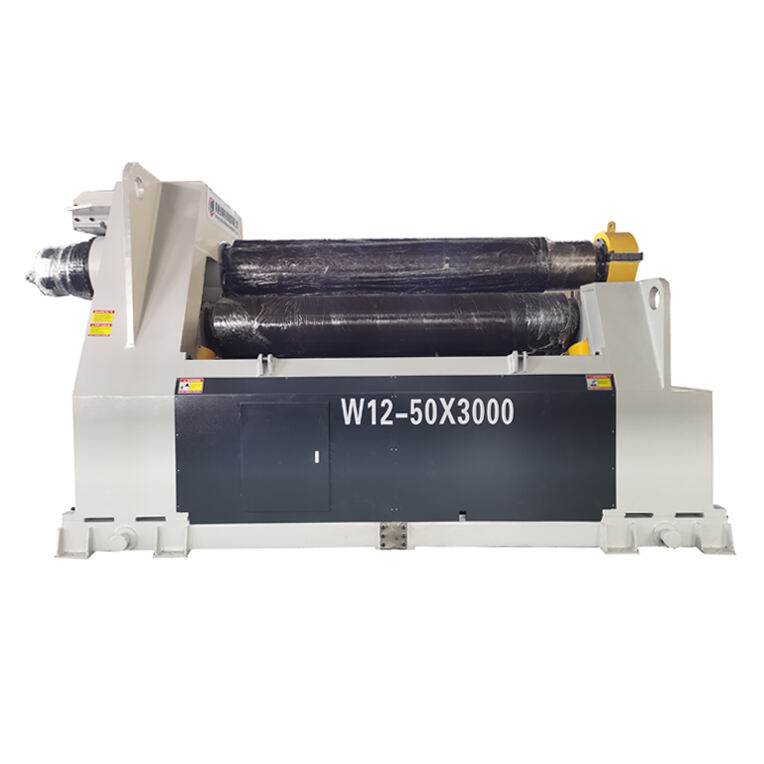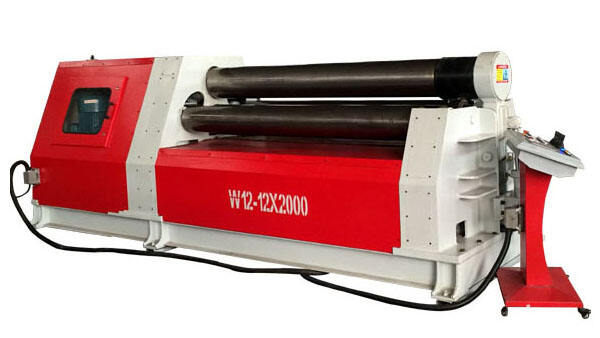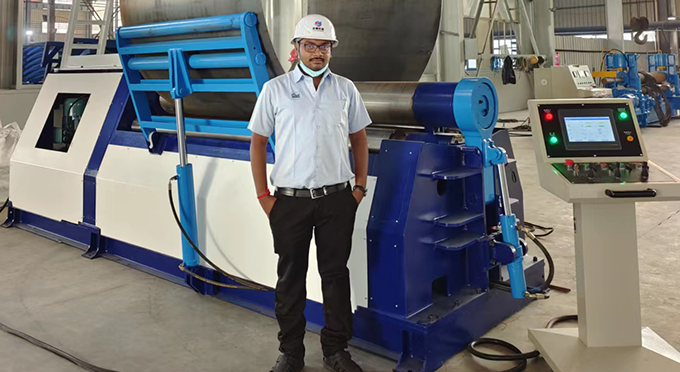Understanding Your Production Requirements for CNC Plate Rolling
How material type influences CNC plate rolling machine selection
Getting material compatibility right really affects how machines perform and what kind of products come out at the end. For steel work, we need pretty strong hydraulic systems, something around 20 tons or more usually. Aluminum is different though because it bends so easily. We have to be super careful with our controls or else we'll end up damaging those surfaces. The latest data from the Material Compatibility Report for 2024 shows something interesting too. When working with stainless steel specifically, four roll CNC systems can actually get about 30% better tolerances compared to regular three roll machines. Why? Because these four roll setups have those extra bending points which help fight against that annoying springback effect everyone deals with.
Matching machine capacity to material thickness and width capacity
Underestimating thickness needs can lead to bearing failure and dimensional inaccuracies. Machines rated for 20mm mild steel require frames 15–20% stronger than those designed for 12mm stock. To ensure operational flexibility:
- Select width capacity at least 10% greater than your widest plate to accommodate clamping
- Use dual-drive rollers to maintain uniform pressure across wide materials
Assessing production volume to determine automation needs
Workshops completing over 500 bends per month typically see a 40% faster return on investment with full CNC automation. For operations handling fewer than 100 pieces monthly, semi-automatic systems are often sufficient. High-volume facilities benefit significantly from programmable axis control, which cuts setup time by up to 70% compared to manual adjustments.
Bending radius requirements and their impact on roller geometry
Tight radii—less than twice the material thickness—require smaller-diameter top rollers (minimum 12x material thickness) and hardened tool steel surfaces to prevent slippage. For example, forming a 15mm inside radius on 10mm aluminum benefits from asymmetric four-roll configurations, which reduce deformation by 25% versus symmetrical three-roll setups.
Evaluating Key Technical Specifications of CNC Plate Rolling Machines
Maximum Material Thickness and Width Capacity for Optimal Performance
When picking out machinery, it's wise to go for something that can handle more than what we usually deal with because materials aren't always consistent. Industry experts generally suggest going with around 20% extra capacity. So if someone typically works with 12 mm steel plates, they should look at machines rated for about 14.4 mm instead. The folks who did the 2024 Metalforming Analysis came to similar conclusions about this approach. And don't forget about width either. Getting something that's roughly 10 to 15% wider than needed makes a big difference when dealing with those tricky asymmetrical rolls where edges tend to get messed up otherwise.
Roller Diameter and Geometry: How They Affect Bending Precision
The size of rollers really matters when it comes to how tight a bend can be achieved. Take for instance, when working with a top roller that's 400 mm in diameter versus one only 200 mm across. The bigger roller lets manufacturers create bends that are about eight times tighter, according to findings from last year's Bending Mechanics research. Now, asymmetric setups where the cone ratio goes beyond 1:3 are great for those special jobs needing things like tapered tubes. But there's a catch worth mentioning here. These non-standard configurations typically take around 30 percent more time to set up properly compared with regular symmetrical arrangements. Something most shop floor managers learn through experience rather than just reading specs.
Determining the Right Machine Size Based on Workshop Space and Workflow
Consider these spatial factors when integrating a CNC plate roller:
- Floor footprint relative to overhead crane clearance (minimum 1.5x machine height)
- Material staging zones should be at least double the maximum plate length
- Include space for downstream processes such as heat treatment or grinding
Smaller shops producing € 50 bends daily often find pyramid-style machines ideal for compact layouts. High-volume operations, however, gain efficiency from linear workflows supported by robotic handling systems.
Control System Compatibility and Scalability for Future Upgrades
Modern CNC platforms using EtherCAT fieldbus protocols reduce signal latency by 40% compared to analog controls. Prioritize systems equipped with:
- IoT-enabled predictive maintenance interfaces
- Multi-axis synchronization ensuring € 0.01 mm positional repeatability
- Cloud-based program libraries for rapid job changeovers
Modular I/O ports allow incremental upgrades, avoiding costly full-controller replacements as automation needs evolve.
Comparing Three-Roll vs. Four-Roll CNC Plate Rolling Machines
Operation Process of a Three-Roll CNC Metal Rolling Machine
Three roll bending machines typically have two stationary bottom rolls and one top roll that can be adjusted to create bends in metal sheets. When working with materials, they pass through the machine in an uneven way, so operators often have to flip them around multiple times to make complete circular shapes. This leaves straight sections along the edges that usually require some kind of pre-bend treatment before final shaping. Although these machines are generally easier to maintain and cheaper when purchased new, their basic design means more hands-on work is needed for complicated components. Precision suffers somewhat compared to other methods, making them less suitable for jobs where tight tolerances matter most.
Why Four-Roller Metal Rolling Machines Offer Better Efficiency and Accuracy
The four roll system adds another lateral roller that actually grabs hold of the material and keeps it positioned correctly during processing. This setup allows for both pre-bending and continuous rolling all in one pass through the machine. According to recent research published last year in machinery design journals, these systems boost alignment stability around 60 percent compared to traditional methods. That makes a big difference when working with thin walled cylinders where hourglass shaped distortions can be a real problem. When manufacturers program their rollers to synchronize properly, they find that springback errors remain under half a degree even in high precision operations. For shops dealing with tight tolerances, this level of control is absolutely essential.
Case Study: Reducing Setup Time by 40% With a Four-Roll CNC Plate Rolling Machine
A midwestern aerospace supplier reduced average setup time by 17 minutes per batch after switching to a four-roll CNC system. The integrated lateral roller eliminated manual centering, while CNC-preset roller gaps cut trial-and-error adjustments by 83%, streamlining production of mission-critical components.
Industry Paradox: When a Simpler Three-Roll System May Outperform Advanced Models
For shops processing under 50 tons annually or specializing in open-profile bends like structural channels, three-roll machines deliver adequate accuracy at 30–50% lower maintenance costs. Their mechanical resilience also makes them better suited for heavy plates (over 6 inches thick), where hydraulic systems face accelerated wear from uneven loading.
Advantages of hydraulic CNC plate rolling machines in high-precision applications
The hydraulic CNC systems come equipped with closed loop controls which adjust the roller pressure and positioning as needed, cutting down on mistakes made by operators. When dealing with tough stuff like stainless steel or titanium alloys, these automated systems actually cut down size inconsistencies by around 30 percent compared to what happens with manual operations. And here's something interesting about them too they monitor forces in real time so they can keep things accurate even if there are slight changes in material thickness, sometimes handling variations of plus or minus half a millimeter without missing a beat.
CNC control and programmable bending: Enabling repeatable, complex shapes
Today's controllers can hold around 500 different programs, which makes it possible to reproduce complex shapes quickly. Think about those fancy parabolas or cone-like structures that manufacturers need all the time. The ability to handle these shapes matters a lot in fields such as aerospace work and making pressure vessels, especially when angles have to stay really tight, like within plus or minus 0.25 degrees. There's also something called automated crowning compensation that helps keep things accurate. Basically, it fixes tiny shifts in the machine when weight gets applied during operation, so the final product stays exactly how it was intended.
Integration of autonomous bending technologies
Advanced CNC rollers now employ self-correcting algorithms that process feedback from laser measurement systems. These autonomous features achieve first-pass success rates over 98% for complex bends, eliminating costly test runs. A 2023 field study confirmed a 40% reduction in setup time through automated roller alignment and optimized bending sequences.
When manual or semi-automatic systems make economic sense
For workshops with fewer than 5,000 annual bends, manual or semi-automatic systems offer practical advantages:
- Lower upfront costs: Semi-automatic models require 35% less initial investment
- Greater flexibility: Operators can adapt quickly to custom or one-off jobs
- Simpler maintenance: Mechanical systems contain 50% fewer electronic components than full CNC setups
These options remain viable for structural steel fabrication or repair work where tolerances above ±1.5mm are acceptable.
Total Cost of Ownership and ROI for CNC Plate Rolling Machine Investment
Balancing initial investment, maintenance, and long-term ROI
Investing in a $250k automated CNC setup can actually pay off quicker than going for the cheaper $180k version most of the time, mainly because it cuts down on labor costs so much. Shops that have switched to these systems with their preset programming options are seeing around 40% fewer hours needed from operators week after week. But don't forget about looking at everything the machine will cost throughout its life. Some research tracked 47 different manufacturing operations and discovered something interesting: those paying 15% more upfront for better quality equipment ended up spending 28% less on repairs and maintenance across five years. Makes sense when you think about it really.
Hidden costs in CNC plate rolling machine ownership
| Cost Category | Average Annual Impact |
|---|---|
| Tooling Adjustments | $8,000–$15,000 |
| Energy Consumption | $3,500–$7,200 |
| Precision Calibration | $1,200–$4,800 |
| Unplanned downtime costs mid-sized workshops $18,000–$35,000 annually in lost productivity. Systems requiring proprietary tooling increase hidden expenses by 19% compared to standardized alternatives. |
Brand reputation and manufacturer support's impact on machine uptime and reliability
When suppliers offer round-the-clock technical support, repair delays drop dramatically - around 73% less than when relying on basic warranty service alone. A recent industry survey in metalworking found something interesting too: most shops (about 82%) that stuck with premium brand equipment saw their machines running smoothly over 95% of the time, while those with cheaper alternatives barely hit 64%. And let's not forget about maintenance. Companies that work with well-known manufacturers tend to get proactive maintenance programs which actually make a difference. These programs help extend the life of roller bearings by roughly 30%, meaning fewer replacements needed and significant savings on parts down the road.
Key Consideration: Premium CNC plate rollers retain 55–70% of their original value after seven years, significantly outperforming economy models, which typically retain only 35–50%.
FAQ Section
What is the main benefit of using four-roll machines instead of three-roll machines?
Four-roll machines offer better efficiency and accuracy in bending processes because they feature an additional roller that helps stabilize material alignment, enabling precise pre-bending and continuous rolling in one pass.
How does automation affect CNC plate rolling machine performance?
Automation enhances CNC plate rolling performance by reducing setup times and errors, increasing the precision and speed of production, and providing programmable options for handling complex shapes.
Why might a manual or semi-automatic system be more suitable for some workshops?
Workshops with fewer than 5,000 annual bends can benefit from manual or semi-automatic systems due to lower upfront costs, greater flexibility for custom jobs, and simpler maintenance than full CNC setups.
Table of Contents
- Understanding Your Production Requirements for CNC Plate Rolling
- Evaluating Key Technical Specifications of CNC Plate Rolling Machines
- Comparing Three-Roll vs. Four-Roll CNC Plate Rolling Machines
- Advantages of hydraulic CNC plate rolling machines in high-precision applications
- CNC control and programmable bending: Enabling repeatable, complex shapes
- Integration of autonomous bending technologies
- When manual or semi-automatic systems make economic sense
- Total Cost of Ownership and ROI for CNC Plate Rolling Machine Investment
- FAQ Section




